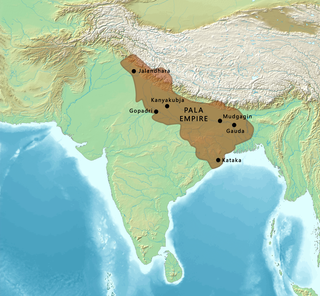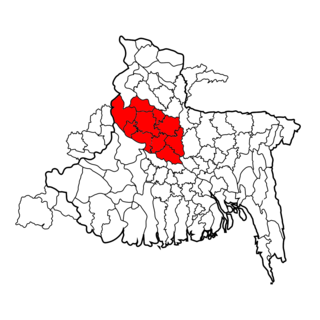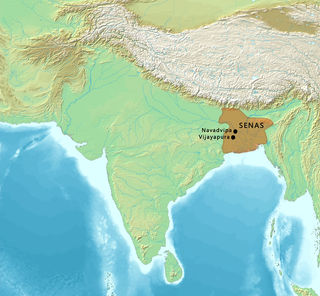Related Research Articles

The Pāla Empire was an imperial power during the post-classical period in the Indian subcontinent, which originated in the region of Bengal. It is named after its ruling dynasty, whose rulers bore names ending with the suffix Pāla. The empire was founded with the election of Gopāla as the emperor of Gauda in late eighth century CE. The Pala stronghold was located in Bengal and eastern Bihar, which included the major cities of Gauḍa, Vikramapura, Pāṭaliputra, Monghyr, Somapura, Ramavati (Varendra), Tāmralipta and Jagaddala.

The Sena dynasty was a Hindu dynasty during the early medieval period on the Indian subcontinent, that ruled from Bengal through the 11th and 12th centuries. The empire at its peak covered much of the north-eastern region of the Indian subcontinent. The rulers of the Sena Dynasty traced their origin to the south Indian region of Karnataka.

Bikrampur was a pargana situated 19 kilometres (12 mi) south of Dhaka, the modern capital city of Bangladesh. In the present day, it is known as the Munshiganj District of Bangladesh. It is a historic region in Bengal and was a part of the Bhawal Estate.
Mahishya is a Bengali Hindu traditionally agrarian caste, and formed the largest caste in undivided Bengal. Mahisyas were, and still are, extremely diverse caste consisting of all possible classes in terms of material conditions and ranks.

Patnitala is an Upazila of Naogaon District in the Division of Rajshahi, Bangladesh.

Varendra, also known as Barind, was an ancient and historical territory of Northern Bengal, now mostly in Bangladesh and a little portion in the Indian state of West Bengal.

Gopala II was the successor to the Pala king Shurapala I in the Bengal-Bihar region of the Indian subcontinent, and the sixth ruler of the Pala line reigning for at least four years. The existence of this king came to light when, in 1995, historian Gouriswar Bhattacharya discovered two copper plate inscriptions of a previously unknown Pala king in Los Angeles County Museum of Art, where these had been sent for cleaning by a private collector. This king got designated as Gopala II; consequently, existing Gopala II and Gopala III were re-designated as Gopala III and Gopala IV, respectively. The text of these two inscriptions were subsequently edited by Ryosuke Furui in 2009.
Vigrahapala III was the successor to the Pala king Nayapala in the Bengal region of the Indian subcontinent, and twelfth ruler of the Pala line reigning for 15 years. He was succeeded by Mahipala II.
Mahipala II was the successor to the Pala king Vigrahapala III in the Bengal region of the Indian subcontinent, and thirteenth ruler of the Pala line reigning for six years. He was succeeded by Shurapala II.
Shurapala II was a ruler of the Pala Empire in the Eastern regions of the Indian subcontinent. He was the successor to the Pala king Mahipala II and fourteenth ruler of the Pala line, reigning for at least two years.
Ramapala also known as Ramapala the Great, was the successor to the Pala king Shurapala II in the Bengal region of the Indian subcontinent, and fifteenth ruler of the Pala line.
Gopala IV, previously called Gopala III, was the successor and son to the Pala king Kumarapala in the Bengal region of the Indian subcontinent, and nineteenth ruler of the Pala line reigning for at least 15 years, proved by a manuscript currently at British library.
Madanapala was the successor to the Pala king Gopala IV in the Bengal region of the Indian subcontinent, and the eighteenth and final ruler of Pala lineage reigning for 18 years. He was succeeded by Govindapala, whose lineage of that name is questionable.
Vijaya Sena, also known as Vijay Sen in vernacular literature, was the son of Hemanta Sena, and succeeded him as a Sena dynasty ruler of Bengal region of the Indian subcontinent. This dynasty ruled for more than 200 years. He conquered Bengal, fighting the kings of Gauda, Kamarupa, and Kalinga. He had a capital in Vijayapuri and Vikramapura.
Nandy or Nandi is a Bengali surname which is found among the Bengali Kayasthas in Indian States of West Bengal, Assam,Tripura and in Bangladesh.

Dibar Dighi is a tank in Bangladesh. An octagonal granite pillar, associated with Kaivarta chief Dibya, who usurped the Pala throne, stands in the centre of the tank.

Mahipala was a notable king of the Pala dynasty, which ruled over much of the eastern regions of the Indian subcontinent between the 8th and 12th centuries. He was the son and successor of Vigrahapala II. Mahipala's reign marked a resurgence in fortunes for the Pala empire, whose boundaries were expanded as far as Varanasi. However, his rule was temporarily hampered by the northern expedition of the Chola Emperor, Rajendra I.

The Varendra rebellion was the revolt against King Mahipala II led by Kaivarta chieftain Divya (Dibyak), a feudal lord of Northern Bengal. The Kaivartas were able to capture Varendra by this rebellion. The revolt might have been the first peasant revolt in Indian history. However, the first phase of the revolt would more appropriately be described as a rebellion of feudal lords (samantas), who would have mobilized the peasants, and the last phase of the revolt was a spontaneous mass uprising.

Telkupi is a submerged location of archaeological interest in Purulia district of West Bengal, India. The area, along with most of the temples situated there, was submerged in 1959 as a consequence to the construction of a dam across Damodar river at Panchet in Dhanbad district, then in Bihar.

Deopara Prashasti described the founder of Sena dynasty Samanthasena, as a migrant Brahmaksatriya from Karnataka. The epithet 'Brahma-Kshatriya' suggests that Senas were Brahmins by caste who took the profession of arms and became Kshatriyas. The Sena kings were also probably Baidyas, according to historian P.N. Chopra.
References
- 1 2 Roy N. (1993). Bangalir Itihas: Adiparba, Dey's Publishing, Calcutta, ISBN 81-7079-270-3, p.583
- 1 2 3 4 5 "Ramacharitam, The". Banglapedia. Retrieved 2021-06-24.
- 1 2 "Sandhyakar Nandi". Banglapedia. Retrieved 2021-06-24.
- 1 2 3 4 5 6 7 8 9 10 11 12 13 14 15 16 Furui, Ryosuke (2014). "CHARACTERISTICS OF KAIVARTA REBELLION DELINEATED FROM THE RĀMACARITA". Proceedings of the Indian History Congress. 75: 93–98. ISSN 2249-1937. JSTOR 44158366.
- ↑ Roy, Kumkum (2009). "The Artful Biographer: Sandhyakaranandin's Ramacharitam". In Ramaswamy, Vijaya; Sharma, Yogesh (eds.). Biography as History: Indian Perspectives. Orient Blackswann. pp. 17–29. ISBN 9788125035213.
- ↑ Sengupta, Nitish K. (2011). Land of Two Rivers: A History of Bengal from the Mahabharata to Mujib. Penguin Books India. p. 65. ISBN 978-0-14-341678-4.
- ↑ Susan L. Huntington (1 January 1984). The "Påala-Sena" Schools of Sculpture. Brill Archive. p. 32. ISBN 90-04-06856-2.
- ↑ Furui, Ryosuke (2014). "Characteristics of Kaivarta Rebellion Delineated from the Rāmacarita". Proceedings of the Indian History Congress. 75: 93–98. ISSN 2249-1937. JSTOR 44158366.
- ↑ "Varendra Rebellion". Banglapedia. Retrieved 2021-06-24.
- ↑ Rahman, Kazi Mostafizur (2012). "Dibar Dighi and Kaivarta Stambha". In Islam, Sirajul; Jamal, Ahmed A. (eds.). Banglapedia: National Encyclopedia of Bangladesh (Second ed.). Asiatic Society of Bangladesh.